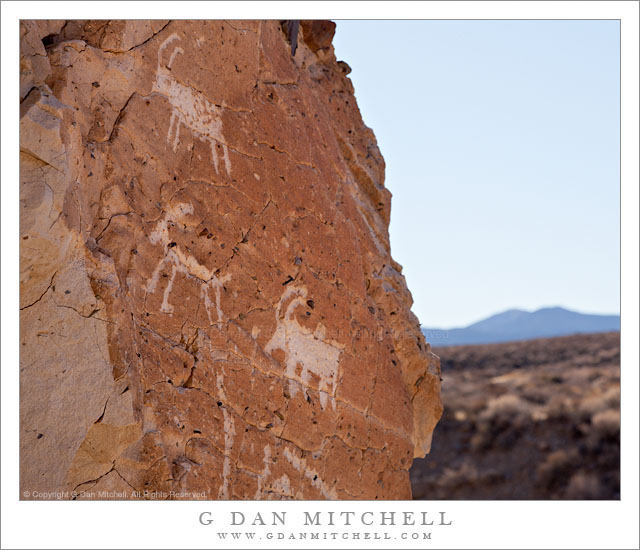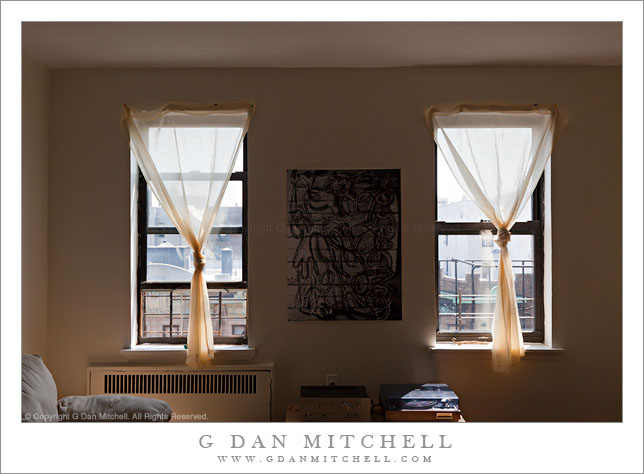I just read the stunning and deeply disturbing story of the theft (not “merely” the all-to-common defacing) of a number of petroglyphs from a California location. (See “Petroglyph Thefts Near Bishop Stun Federal Authorities, Paiutes”) Apparently a group of depraved individuals hauled rock-cutting equipment to the site and sawed out the rocks holding several examples of native rock art, defacing and destroying other examples in the process. Anyone who has visited the better known examples of rock art is aware that a certain pathetic sub-group of the human race finds itself unable to resist the temptation to add their own “art” or deface that which is already there, but this incident represents a new low.

Photographers, those who operate photography workshops, and those of us who write about photography need to take this as an opportunity to think very carefully about how much information we should share about fragile places and things and about where and how we do our sharing. A few years ago I wrote about an occasion on which some friends and fellow photographers called me out on this (“Disclosing Photo Locations: How Much Information is Too Much?”), causing me to re-think how and what I write about my photographs and the places where I make them.
Here is the problem, more or less. “Back in the day,” we might well share what we knew about certain places and subjects without much care at all. While we certainly would not blabber about fragile places in front of people who we thought might disrespect or even damage them, we had no qualms about sharing information with trusted friends. And, in fact, the dangers of that kind of sharing in the pre-web world were not really all that great. The word-of-mouth sharing reached very small number of people, and it was unlikely (though not quite impossible) that the information would eventually get to “the bad guys.” We could even argue that we were serving a greater good by sharing this knowledge with others who should know, and whose voices might contribute to the protection of these places and subjects.
However the web has changed everything. Anything that you or I post today becomes cataloged, is searchable, is readily shared and re-shared, becomes linked to other pieces of information about the same subjects… and can be seen by millions of people you don’t know, among them many whom you would not trust and some that you would never share this stuff with. That’s the new reality. Among the people who may see our work and read our descriptions online are thoughtless barbarians who stand on top of fragile arches, who climb on tufa towers, who inscribe their own “art” into ancient sites, who drive all over the landscape, who remove “sailing rocks” from their playa homes, who leave trash in the landscape, who create trails across wilderness landscapes, who harm wildlife, who party in sacred and quiet places, and more.
As photographers who share our work and write about it and even take other people to these places, we have a responsibility to our subjects to do everything we can to protect them, even if this means restricting what we say, what we share, and where we share it.
Using photographs of rock art as an example, I think that responsible photographers should adopt the following policies:
- When posting a photograph, if location information is not important to understanding the photograph, don’t share such information at all.
- When some location context is actually important – and sometimes it is – anonymize it as much as possible. Perhaps the name of the 200-mile-square geographical region is sufficient. Perhaps the word “canyon” can be used without naming the canyon.
- When making photographs of such things, avoid the inclusion of surrounding or background elements that will help the cretins figure out the location. I know this is hard, given the photographic potential that you’ll need to forego – but a your discretion serves a greater good, and you can figure out an effective alternative way to shoot these subjects. (For my part, I enjoy the challenge of trying to work out an effective composition that doesn’t give things away.)
- If you realize that you have been too open about information, edit your text, remove unnecessary or risky references, or withdraw certain photographs. (There used to be an extensive guide to photographing in Death Valley on this web site – it was removed for such reasons.)
- When writing about photographs of such subjects, always include some reference to their fragility, their significance, the power of experiencing them, and the responsibility of protecting them.
- Recognize that everything you share, no matter the online forum in which you share it, will eventually reach a much wider audience – and think about how much you want the lowest-common-denominator types in that audience to know.
- Exercise caution even when you share directly with those you know. Share only with those who you trust to share your love for and concern about these places, and only with those who will refrain from sharing more widely. Perhaps sharing with “online friends” is a bit to liberal – maybe you want to restrict this to people you really know and work with. Even with direct, personal sharing… be conservative.
- As tremendously tempting as it is – for financial as well as self-aggrandizement reasons – don’t take your workshops to these places. I’m afraid it isn’t enough to think you have told your students how fragile these places are. Once they leave they will share their photos, they will talk about your workshop, they will give directions, they will brag about the cool thing you showed them… and they’ll do it in that linked, searchable, uncontrollable world of the web.
- Speak about these issues more openly – with other photographers, online, in your workshops, and so forth.
Our work to photograph these subjects and the photographs that result from this work should be evidence of our recognition of the importance of these places and of protecting them – and not something that will contribute to endangering them.
Update: A few months later the petroglyphs were recovered. Final outcome in the case is not known as of this writing.



